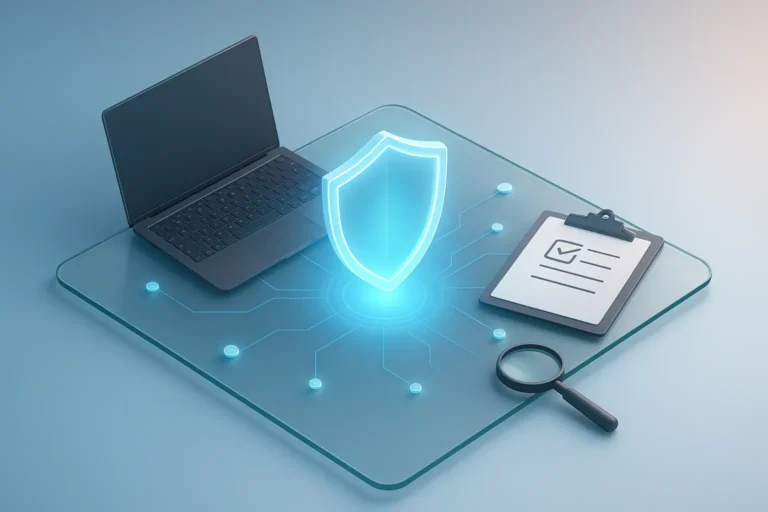Cybersecurity compliance audits require meticulous preparation and strategic approaches to meet increasingly complex regulatory requirements. Industry experts recommend implementing proactive measures such as continuous monitoring, regular pre-audits, and cross-functional assessments to maintain optimal security posture. Following established best practices not only streamlines the audit process but also strengthens overall security infrastructure and builds stakeholder trust.
- Ask Five Core Questions for Audit
- Simulate Security Incidents Before Official Reviews
- Conduct Monthly Micro-Audits with Staff
- Prioritize Cross-Functional Teams for Comprehensive Assessment
- Map Requirements to User Behaviors
- Store Evidence for Quick Audit Retrieval
- Maintain Living Controls Registry for Seamless
- Structure Audits Around Established Security Frameworks
- Deploy Compliance Management Software for Documentation
- Take Ownership with Clear Team Accountability
- Build Trust Through Transparent Audit Processes
- Implement Continuous Monitoring for Audit Readiness
- Conduct Regular Pre-Audits to Identify Vulnerabilities
- Front-Load Documentation During Developer Onboarding
- Treat Compliance as Ongoing Operational Procedure
Ask Five Core Questions for Audit
I build audit readiness into my teams from the start, rather than treating audits as one-off events. The idea is to anticipate what auditors will look for and make sure the groundwork is always in place. For every area that could be audited, we ask five core questions:
What is the policy or standard that governs this area?
What is the defined scope of that policy/standard, in other words, what’s in and out?
For everything not in scope, how are we comfortable that it’s where it should be?
How is this requirement measured, and how do we know if conditions change?
How is this process reviewed to ensure it remains valid over time?
By thinking in this way, we create a scalable system that makes audit preparation far less disruptive and ensures controls align with business realities. This approach has helped me successfully navigate dozens of audits and regulatory exams.
One best practice I emphasize is teaching teams to “anticipate the second and third question.” An auditor rarely stops at the first answer. If you can clearly respond to the initial question and already have supporting evidence for the natural follow-ups, the audit goes smoothly and efficiently. This goes far beyond audits and is a valuable skill in any executive communication.
Equally important is how questions are answered. We never hide information, but responses must be precise and scoped to the question asked. Talking about future plans that aren’t yet in place can be tricky and should be done with care; otherwise, it may invite unnecessary scrutiny. The key is to answer with detail and accuracy for what exists today, while being prepared to discuss future improvements if explicitly asked.
This combination of preparation and readiness, anticipating follow-ups, disciplined communication, and careful handling of future-looking statements turns audits from stressful checkpoints into opportunities to validate that the cybersecurity program is working as intended.

Simulate Security Incidents Before Official Reviews
Internal cybersecurity compliance audits are something I do very much both as a CEO and security guy. One thing that I have found to be invaluable is running “PRE-AUDIT BREAK SIMULATIONS” with my leadership team prior to an official review. We don’t merely sit and review policies; we physically WALK THROUGH a scenario — typically, a ransomware attempt, an insider threat or the breach of a network using a phishing attack (in which emails are used to steal passwords or data), and then document EVERY decision and response in real time.
This method has caught things that a typical audit would miss, such as when we discovered a small group of admins who hadn’t enrolled in MFA. Transforming audits from a once-a-year headache to a collaborative task, we’ve decreased the time it takes to address issues and have created an environment in which everyone feels like they’re responsible for security. What I would tell other leaders: Use your audits to show that your team can perform under pressure…that’s where you’ll really learn about the areas of actual strength and weakness.

Conduct Monthly Micro-Audits with Staff
After 12 years of winning “Best of Hays” and handling cybersecurity for hundreds of Texas businesses, I’ve learned that most compliance audits become disasters because companies audit in isolation instead of integrating it with their security operations.
My game-changing practice: We conduct “continuous micro-audits” throughout the year instead of one big annual review. Every month, we randomly select 3-4 security controls and audit them thoroughly with the actual staff who use them daily. This means when the real audit comes, we’ve already tested 80% of our controls and fixed issues in real-time.
Here’s the concrete proof this works: One of our legal clients had a surprise HIPAA compliance review last spring. While most firms spend weeks gathering documentation, we pulled up our monthly micro-audit reports showing staff training completion rates, access control reviews, and risk assessment updates. We demonstrated compliance in under 4 hours instead of the typical 3-week scramble.
The secret sauce is involving your front-line employees in these micro-audits, not just IT staff. When your receptionist can explain why she follows specific data handling procedures because she helped audit them last month, that’s when auditors know your compliance culture is real.

Prioritize Cross-Functional Teams for Comprehensive Assessment
I approach internal cybersecurity compliance audits as ongoing processes rather than one-time events.
My first priority is always establishing clear objectives that align with both regulatory requirements and our organization’s risk tolerance. When preparing for audits, I assemble cross-functional teams that include not just IT professionals but also representatives from legal and operations. This diversity ensures we capture compliance gaps that might be missed by a purely technical review. I’ve found that conducting thorough risk assessments before diving into control evaluations saves significant time. By identifying our highest-risk areas first, we can prioritize our audit efforts where they matter most. During data collection, I rely heavily on automated tools to gather evidence and validate controls. Manual processes simply can’t keep pace with the dynamic nature of modern IT environments, and automation reduces human error while providing real-time insights.
My analysis phase focuses on translating technical findings into business language that executives can understand. A compliance gap means nothing if leadership doesn’t grasp its potential impact on operations or reputation. The best practice I swear by is implementing continuous monitoring rather than point-in-time assessments. Traditional annual audits create dangerous blind spots, while automated continuous monitoring catches compliance drift before it becomes a violation. I treat follow-up actions with the same rigor as the initial audit. Creating detailed remediation plans with clear ownership and deadlines ensures that identified gaps actually get closed rather than becoming recurring findings. Most importantly, I view compliance audits as opportunities to strengthen our security posture, not just checkbox exercises. When teams understand that audits protect the business rather than punish departments, they become active participants in maintaining compliance rather than reluctant subjects.

Map Requirements to User Behaviors
After leading VIA Technology through major IT implementations like the City of San Antonio’s SAP project and University Health Systems deployments, I’ve seen how traditional audit approaches create unnecessary stress and expose real vulnerabilities.
My core practice is what I call “layered access validation” – we map every compliance requirement to actual user behaviors across our low-voltage, surveillance, and AV systems. Instead of checking boxes on paper, we verify that our access control installations actually enforce the compliance rules they’re supposed to protect.
For example, when we handled the Homeless Management Information Systems project for San Antonio, we found that 40% of compliance failures happen at the integration points between different systems – the spots where your access control talks to your surveillance, or where your AV equipment connects to your network. Most audits miss these intersections completely.
The key insight from my Stanford and Kellogg executive training: audit your technology stack the same way you built it. Since we install and integrate these systems from design to support, we audit following that same end-to-end path rather than treating each component separately.

Store Evidence for Quick Audit Retrieval
In my very first audit, my auditor explained to me something that stuck: “If you can provide the evidence within 3 minutes after being asked for it, it’s considered valid. If not, it raises questions about the authenticity of the evidence.”
This directly overlaps with the usage of GRC Tools. In the ideal case, when using one, everything is supposed to be within that tool, i.e., a single source of truth can be established as and when required. This includes evidence, drills, policies, procedures or plans—everything readily available from the same source.
So, the best practice is simple: keep everything well-managed. Collate all evidence and all policies/procedures maintained, maybe in a GRC Tool or maybe in a Google Sheet with names against links, whatever works the best for you.
Another important point, which is often overlooked, is thinking of evidence as a checklist item. It must be an actual implementation of the standard you are being audited against. Ticking the box is super simple; anyone can do it, but good auditors quickly notice and see through such evidence not aligning with reality.
A password policy shouldn’t just be a PDF stored somewhere. It is validated by how password resets are enforced, their frequency, complexity rules on an actual system—not just on paper. An incident drill isn’t a document but is demonstrated through drills or records of past incidents and their corrective actions.
At the same time, implementation must be practical. You can never achieve 100% implementation for every control in security, which is where risk acceptability comes into play. Compliance is not about doing everything, but doing what’s practical, i.e., balancing security requirements with business needs.
At the end of the day, audits are not about showing that you have all the paperwork in the world, but proving real practices, balanced with business needs. It is what builds trust among the auditors (internal/external) and the stakeholders.

Maintain Living Controls Registry for Seamless
Internal cybersecurity audits can feel overwhelming if they’re treated as a once-a-year event. At Deemos, we handle them as a continuous process, not a checkpoint. That means keeping compliance baked into daily workflows rather than scrambling before an audit cycle.
One best practice that has worked well is maintaining a “living controls registry.” Instead of static documentation, we track security controls in a shared system that updates automatically when configurations or policies change. This makes evidence collection seamless and ensures there are no surprises during an audit.
It also has a cultural effect, as teams view compliance as part of secure development, not an external burden. That shift makes the audits faster, smoother, and more valuable.

Structure Audits Around Established Security Frameworks
Internal cybersecurity audits are a critical element of any organization’s data governance and risk management framework. These audits help validate adherence to contractual customer/vendor obligations, internal policies, and applicable regulatory requirements such as the CCPA, COPPA, and the GLBA.
Standard practice includes conducting bi-annual vulnerability scans using in-house tools such as Qualys or Rapid7. Penetration testing, by contrast, should be performed annually by qualified third-party providers like Rapid7 or CrowdStrike to ensure objectivity and independent verification of network security.
A widely recognized best practice is to structure cybersecurity audits around established frameworks such as NIST or ISO 27001. This includes maintaining and routinely auditing against formal policies governing application security, access management, and information security governance. Such alignment ensures consistency, supports audit readiness, and strengthens stakeholder and regulatory trust.

Deploy Compliance Management Software for Documentation
I propose using some form of automated or compliance management software such as regulance.io. When it comes to compliance audits, the biggest challenge is always to put together the evidence that is required to demonstrate compliance. Organizations are at risk of not doing this in a timely manner, and also documenting properly the things that they need to adhere to to remain compliant.
Documentation is key during compliance, and you need to maintain good records. Another advantage of using a compliance management tool is the ability to assign different users tasks and properly follow up until they are done. This is essential for both medium and large companies. It helps you remove the chaos during the process.

Take Ownership with Clear Team Accountability
When I manage internal cybersecurity audits, my focus is on preparation and alignment. Compliance isn’t just about checking boxes; it’s about ensuring that policies are understood, consistently applied, and thoroughly documented throughout the organization.
I lead by ensuring my team takes ownership of the process. I define the audit scope, gather necessary evidence, such as access logs and configuration records, and assign clear responsibilities to ensure a thorough and accurate audit. Engaging the team early and explaining why compliance matters prevents surprises and ensures everyone understands their role.
Automation also plays a key role. Monitoring dashboards and reporting tools enable my team to track compliance continuously, allowing us to address gaps well before auditors arrive. Pre-audit reviews help identify issues early, making the formal audit smoother and more efficient.
The best practice I follow is driving early engagement and team accountability. When the team understands expectations upfront and takes ownership, audits become a collaborative, proactive process, strengthening a culture of ongoing compliance.

Build Trust Through Transparent Audit Processes
Conducting cybersecurity compliance audits is less about box-checking and more about building trust in systems and processes. A consistent best practice is ensuring that audits are approached with transparency—every finding, no matter how small, is treated as an opportunity to strengthen defenses rather than as a fault-finding exercise. This mindset encourages teams to be open and collaborative, which makes the process more effective.
Another key element is involving cross-functional stakeholders early. Cybersecurity is not only an IT responsibility; finance, HR, and operations all touch sensitive data. Bringing them into the audit process ensures that compliance isn’t seen as a siloed activity but as a shared organizational responsibility. This broader participation helps uncover risks that might otherwise go unnoticed and creates a stronger culture of security overall.

Implement Continuous Monitoring for Audit Readiness
At Ronas IT, we handle internal cybersecurity compliance audits through a rigorous, continuous ‘readiness’ posture rather than a scramble before an audit date. One best practice we follow is implementing automated compliance monitoring tools that constantly scan our infrastructure and systems against our defined security policies (e.g., ISO 27001, GDPR). This continuous monitoring flags non-compliant configurations or activities in real-time. This approach allows us to address issues proactively. This approach not only ensures we’re always prepared for an audit but also significantly reduces the stress and manual effort involved. It transforms audits from reactive events into a validation of our ongoing, robust security practices, ensuring data integrity and client trust.

Conduct Regular Pre-Audits to Identify Vulnerabilities
To handle internal cybersecurity compliance audits effectively, organizations should conduct regular internal audits to assess their compliance status before the official audit. This practice helps identify vulnerabilities, ensure adherence to regulatory standards, and maintain a robust security posture.
A best practice to follow is to maintain detailed documentation of all security policies, procedures, and controls. This documentation is crucial for auditors to verify compliance and for the organization to demonstrate its commitment to cybersecurity.
Additionally, organizations should keep their systems and software updated, strengthen identity and access management, prepare for incident response and reporting, secure third-party vendor compliance, and train employees on compliance and security practices. These steps not only help in passing the audit but also enhance the overall cybersecurity posture of the organization.

Front-Load Documentation During Developer Onboarding
Our best practice is to treat every remote developer’s onboarding as the first step of a compliance audit. When working with global talent, the biggest risk is not being able to produce vendor security evidence on demand. Instead of scrambling when an audit begins, we front-load the entire documentation process so that compliance is established before a developer ever writes a line of code.
This means that before granting system access, we collect and file all necessary security documentation, from signed access control policies to acknowledgements of data handling protocols. When auditors request evidence for a specific contractor, we don’t need to chase anyone down. The proof is already timestamped and stored in their onboarding file, turning a potential fire drill into a simple reporting task. And when you’re that organized, clients notice.

Treat Compliance as Ongoing Operational Procedure
Instead of treating cybersecurity compliance audits as isolated events, I would treat them as regular operational procedures. This means the organization maintains up-to-date system inventories, access controls, and security policies, while ensuring that every change or incident is properly documented. By doing so, compliance is not a once-a-year scramble, but an ongoing discipline.
When an audit occurs, the company is already prepared, and there’s no need for last-minute evidence collection or rushed remediation. Instead, the audit becomes an opportunity to validate the security posture of an organization, identify areas for improvement. For example, one of the key aspects when it comes to compliance protocols is how fast an organization can deal with the event of failure and get all the operations back on track (so to speak, restore capabilities), and demonstrate transparency to stakeholders. This approach also helps foster a culture of accountability and continuous compliance.




